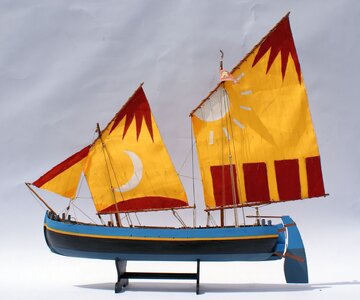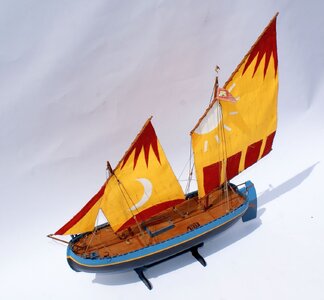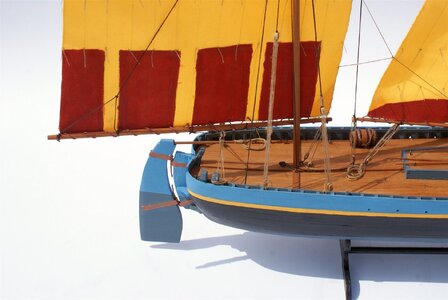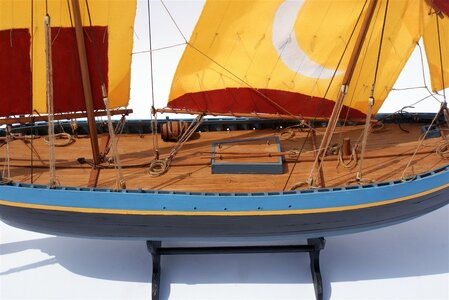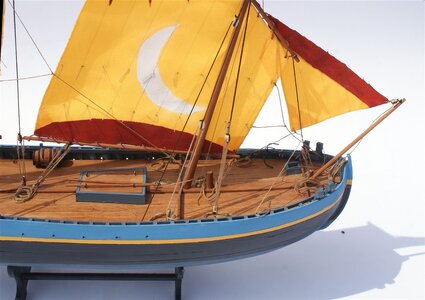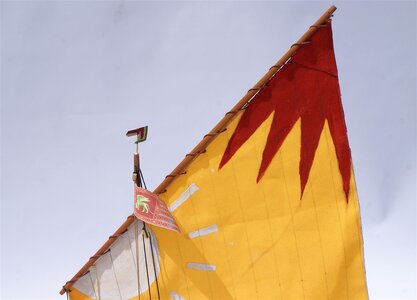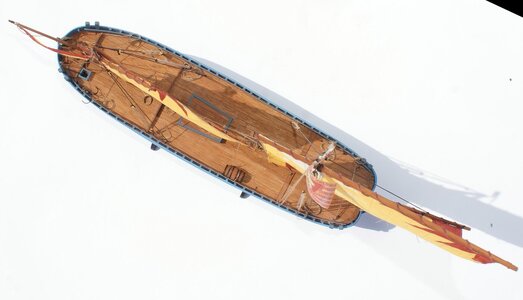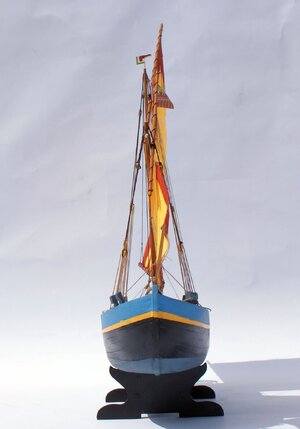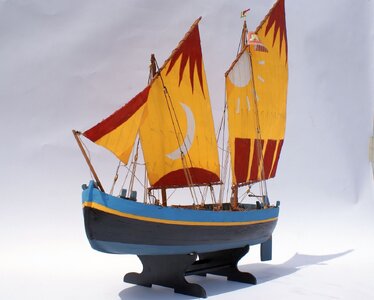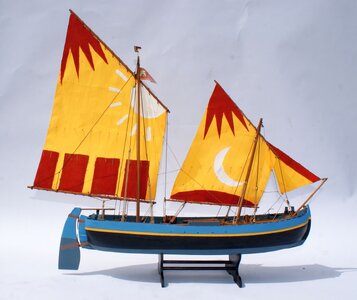Part 1 of 2
In various information collected on the Internet, the “Tartane” is shown as a sharp-prowed boat, with a rigging with lateen sails and a rudder no deeper than the keel, at first glance different from the Chioggiotta Tartane which is a boat of Venetian origin used until the end of the 19th century. On the other hand, the Chioggiotta Tartane has great similarities with the Bragosso (or Bragozzo); it is longer than the latter, with similar rigging (sail on the third deck) and rudder sizes, but in plan, the Tartane is less slender (beam/length ratio).
François-Edmond Pâris in the album «Souvenirs de marine conserves, ou Collection de plans de navires de guerre et de commerce et de bateaux divers de tous les pays tracés par les constructeurs ou marins» from 1879 shows plans of tartanes; in this project, I have considered following his plan entitled “MER ADRIATIQUE – TARTANE 1882”, ratified with the plans of the scale model “Tartana da pesca Chioggiotta” prepared by Mario Marzari (3.6.1981), although in the latter he does not show it, I have considered including a bowsprit (placed next to the bow stem), as it appears in the plans of A. Paris. I am going to paint the hull with different colours, choosing grey for the hull, black and light blue for the rest of the hull. The design and colours of the sails will be different from the known designs of boats in the area, as they are family marks.
As I indicated above, the plans were taken from the work of Mario Marzari from which I translate some paragraphs that expand on the origins of this ship.
“The term tartane or tartana is well known in the Mediterranean and could derive from the oldest naval names: the tarida or the tarte, from low Latin, or from the modern Provençal tartano, corresponding to bird of prey, or from the modern Provençal Tartane, meaning falcon.”
“In the Adriatic there is news of Tartane as early as the 14th century, as E. Bellemo points out in his contribution to the powerful work "The lagoon of Venice", but there are specific difficulties in interpreting the data of the time and the citations, given that at that time both small coastal tartans and war tartans, called large tartans, as well as fishing tartans called fishing boats, were very widespread. In this case we are interested in the latter, one of the oldest working boats in the Adriatic, which marked the history of the Chioggia navy, where in ancient times it was better known as Nascara. Its origins are lost in time and perhaps date back to the ancient Venetian boats, once so widespread in the Adriatic basin.”
“The Tartane Chioggiotta reached its peak development around the 17th century, its epic history coming to an abrupt halt when, following continuous complaints from Rovinj fishermen about the indiscriminate fishing of chioggiotti, the Senate of the Republic of Venice, on August 9, 1770, issued a decree preventing tartanes from Burano and Chioggia from going fishing in Istrian waters. There was then no longer any need to build these large boats, mainly used by companies to go to the eastern waters of the Adriatic, rich in fish, and instead a boost was given to the use of bragozzo, for coastal and lagoon fishing. Having been informed of the immediate reduction of the tartan fleet, which had fallen from 188 to 154 in about a decade, the Senate repealed the previous provisions on 31 March 1781; nevertheless, the decline of the tartane was inevitable. The builders of Chioggia had already improved the bragozzo by enlarging and reinforcing it, so that it could also be used for deep-sea fishing.
“As this boat (the bragosso) was more versatile, cost almost a third of the tartane, employed a smaller crew and offered greater profits, the process was unstoppable. In 1837 there were 108 tartanes in total, to be reduced to 45 in 1866, until almost disappearing in 1891: only two tartanes remained, owned by the Rossi brothers. Then this boat disappeared and was completely lost in the memory of sailors and historians of the sector, being immortalized by Luigi Fincati in a panel of the well-known "Souvenirs de Marine" (1886) by Admiral E. Paris.”
2. References
“Tartane da Pesca – A Fishing Vessel from Chioggia” Mario Marzari
 www.chioggiamuseogalleggiante.com
https://es.wikipedia.org/wiki/Tartane_(n%C3%A1utica)
www.chioggiamuseogalleggiante.com
https://es.wikipedia.org/wiki/Tartane_(n%C3%A1utica)
https://dalvenetoalmondoblog.blogspot.com/2017/01/il-bragozzo-erede-della-Tartane.html
3. Construction of the model
The sections for the frames, the shape of the deck and the dimensions of the mast were obtained from the indicated plans and the hull lines. The false keel, frames and main parts were drawn in AutoCAD and laser cut on 4 mm and 1.5 mm plywood sheets. The dimensions of minor elements were taken to the scale of the same plans. The pieces were disassembled, sanded and displayed. They were glued together with white glue, aligned and mounted on a frame. For the hull's hull, 2x5 mm cedar planks were used; for the gunwale, a 1 mm thick piece was shaped. They were then brushed and sanded to eliminate protrusions and differences between the planks. They were sealed with a mixture of putty, wood sawdust and white glue, filling the joints and deficiencies in the lining; 100, 150 and 225 grit sandpaper was used
After checking the sanding, diluted acrylic paint was used, grey for the hull, black and light blue for the topside. A yellow strip was placed along the hull. The shape of the deck was a little short, so 1 cm strips had to be added to the bow; after correcting this, the deck lining was prepared.
0.5 mm thick veneer was cut to simulate the deck planking, the battens would be 6 x 90 mm to be installed in a three-by-three arrangement, the edges were blackened with charcoal and glued with white glue. The nailing was simulated with a punch and the tip of a pencil. Then it was sanded with 250 grit sandpaper and the aging was simulated with very diluted walnut stain. The deck was taken and mounted on the hull.
The main and foremasts, the yards, the booms and the bowsprit were cut from cedar wood, and the corresponding taper was given using a brush and coarse and fine sandpaper; some holes were drilled and stained with light walnut. After the deck was assembled and glued, the bow and stern bitts were placed, as well as the rails of the same grey colour as the inner face of the bow. The entrance to the hold, which has a trapezoidal plan, was installed, as well as additional planks along and perpendicular to the ship's beam. Finally, the rudder, which has a very special shape and size and is a characteristic of this ship, was prepared and painted. The central bitt, the masts and the bowsprit were also installed.
The dimensions of the sails were taken from the plan of St. Paris and transferred to a paper to be used as a template for cutting the fabric. I took the liberty of modifying the drawings on the sail, as well as the theme and colours. A piece of fabric of the desired colour (dark yellow) was obtained, which was difficult to stick together, so it was decided to cut them to the exact size and glue a thick cotton thread reinforcement to their edges (with contact glue). On the upper part of the mainsail there is a figure of a “Denti” and on the lower part the figure of “Tovaglioli”, both in ochre. The central part has a radiant sun in white as a singular figure. On the upper part of the foresail there is a figure of a “Denti” and on the lower part the figure of “Trave corvo”, both in ochre. The central part has a crescent moon in white as a singular figure. On the jib there is a “Trave” in an inclined position. They have been painted on both sides of the sail with acrylic paint.
The mainsail and foresail are mounted on their respective peak and boom, also tying the blocks and ropes. We use a thick cotton thread in a “raw” colour for the running rigging. For the elements for hoisting and fixing the yardarm, thicker cotton threads will be used, darkened and hardened with Judean bitumen. As complementary elements of the deck, a wooden barrel tied to the bow, an anchor and its rope will be placed. At the top of the masts the flag of the Republic of Venice and a multicoloured weather vane will be placed.
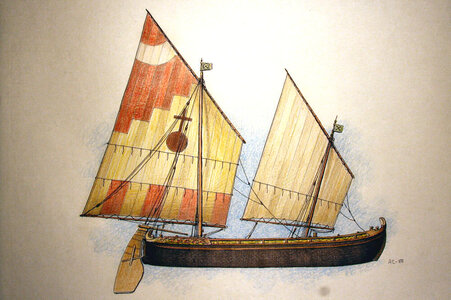
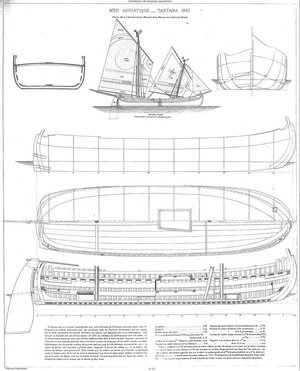

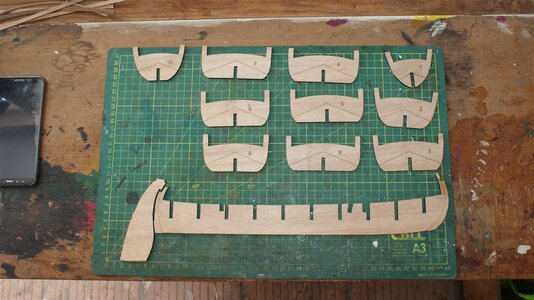


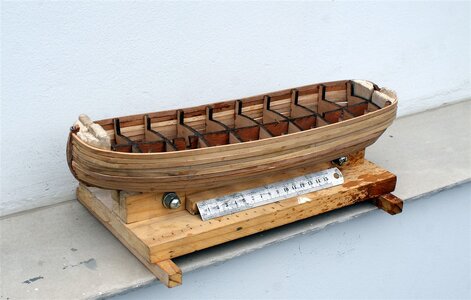
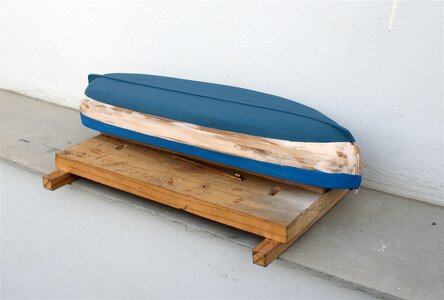


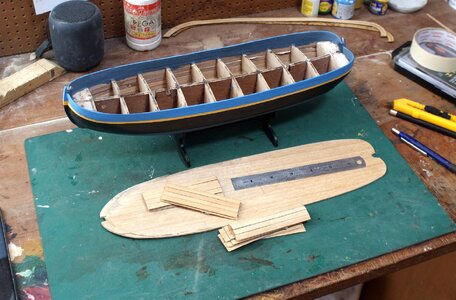
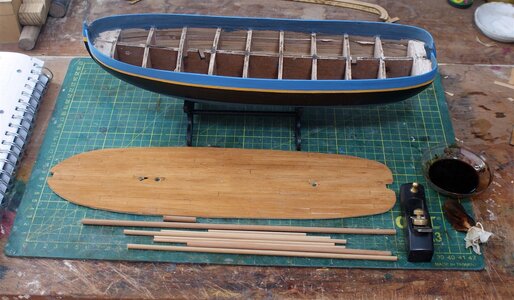
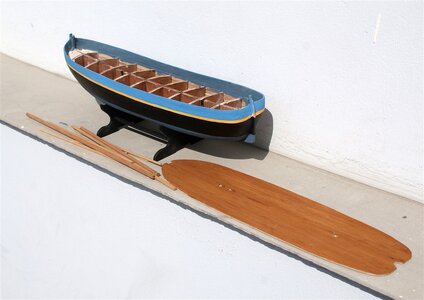
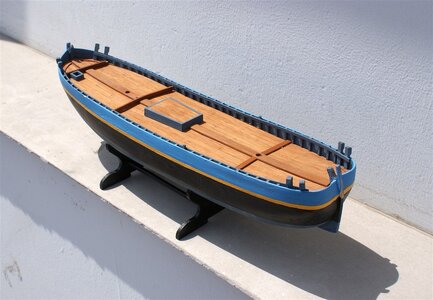
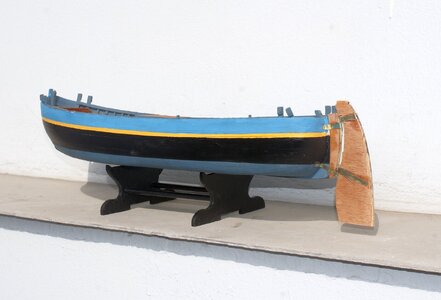

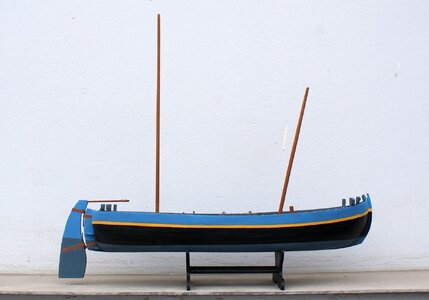

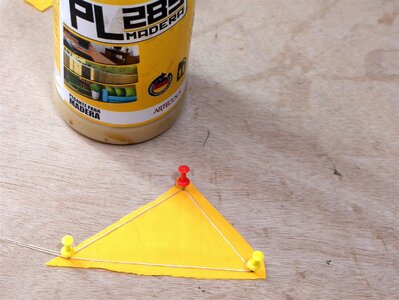






In various information collected on the Internet, the “Tartane” is shown as a sharp-prowed boat, with a rigging with lateen sails and a rudder no deeper than the keel, at first glance different from the Chioggiotta Tartane which is a boat of Venetian origin used until the end of the 19th century. On the other hand, the Chioggiotta Tartane has great similarities with the Bragosso (or Bragozzo); it is longer than the latter, with similar rigging (sail on the third deck) and rudder sizes, but in plan, the Tartane is less slender (beam/length ratio).
François-Edmond Pâris in the album «Souvenirs de marine conserves, ou Collection de plans de navires de guerre et de commerce et de bateaux divers de tous les pays tracés par les constructeurs ou marins» from 1879 shows plans of tartanes; in this project, I have considered following his plan entitled “MER ADRIATIQUE – TARTANE 1882”, ratified with the plans of the scale model “Tartana da pesca Chioggiotta” prepared by Mario Marzari (3.6.1981), although in the latter he does not show it, I have considered including a bowsprit (placed next to the bow stem), as it appears in the plans of A. Paris. I am going to paint the hull with different colours, choosing grey for the hull, black and light blue for the rest of the hull. The design and colours of the sails will be different from the known designs of boats in the area, as they are family marks.
As I indicated above, the plans were taken from the work of Mario Marzari from which I translate some paragraphs that expand on the origins of this ship.
“The term tartane or tartana is well known in the Mediterranean and could derive from the oldest naval names: the tarida or the tarte, from low Latin, or from the modern Provençal tartano, corresponding to bird of prey, or from the modern Provençal Tartane, meaning falcon.”
“In the Adriatic there is news of Tartane as early as the 14th century, as E. Bellemo points out in his contribution to the powerful work "The lagoon of Venice", but there are specific difficulties in interpreting the data of the time and the citations, given that at that time both small coastal tartans and war tartans, called large tartans, as well as fishing tartans called fishing boats, were very widespread. In this case we are interested in the latter, one of the oldest working boats in the Adriatic, which marked the history of the Chioggia navy, where in ancient times it was better known as Nascara. Its origins are lost in time and perhaps date back to the ancient Venetian boats, once so widespread in the Adriatic basin.”
“The Tartane Chioggiotta reached its peak development around the 17th century, its epic history coming to an abrupt halt when, following continuous complaints from Rovinj fishermen about the indiscriminate fishing of chioggiotti, the Senate of the Republic of Venice, on August 9, 1770, issued a decree preventing tartanes from Burano and Chioggia from going fishing in Istrian waters. There was then no longer any need to build these large boats, mainly used by companies to go to the eastern waters of the Adriatic, rich in fish, and instead a boost was given to the use of bragozzo, for coastal and lagoon fishing. Having been informed of the immediate reduction of the tartan fleet, which had fallen from 188 to 154 in about a decade, the Senate repealed the previous provisions on 31 March 1781; nevertheless, the decline of the tartane was inevitable. The builders of Chioggia had already improved the bragozzo by enlarging and reinforcing it, so that it could also be used for deep-sea fishing.
“As this boat (the bragosso) was more versatile, cost almost a third of the tartane, employed a smaller crew and offered greater profits, the process was unstoppable. In 1837 there were 108 tartanes in total, to be reduced to 45 in 1866, until almost disappearing in 1891: only two tartanes remained, owned by the Rossi brothers. Then this boat disappeared and was completely lost in the memory of sailors and historians of the sector, being immortalized by Luigi Fincati in a panel of the well-known "Souvenirs de Marine" (1886) by Admiral E. Paris.”
2. References
“Tartane da Pesca – A Fishing Vessel from Chioggia” Mario Marzari
chioggiamuseogalleggiante.com - chioggiamuseogalleggiante Resources and Information.
chioggiamuseogalleggiante.com is your first and best source for all of the information you’re looking for. From general topics to more of what you would expect to find here, chioggiamuseogalleggiante.com has it all. We hope you find what you are searching for!
 www.chioggiamuseogalleggiante.com
www.chioggiamuseogalleggiante.com
https://dalvenetoalmondoblog.blogspot.com/2017/01/il-bragozzo-erede-della-Tartane.html
3. Construction of the model
The sections for the frames, the shape of the deck and the dimensions of the mast were obtained from the indicated plans and the hull lines. The false keel, frames and main parts were drawn in AutoCAD and laser cut on 4 mm and 1.5 mm plywood sheets. The dimensions of minor elements were taken to the scale of the same plans. The pieces were disassembled, sanded and displayed. They were glued together with white glue, aligned and mounted on a frame. For the hull's hull, 2x5 mm cedar planks were used; for the gunwale, a 1 mm thick piece was shaped. They were then brushed and sanded to eliminate protrusions and differences between the planks. They were sealed with a mixture of putty, wood sawdust and white glue, filling the joints and deficiencies in the lining; 100, 150 and 225 grit sandpaper was used
After checking the sanding, diluted acrylic paint was used, grey for the hull, black and light blue for the topside. A yellow strip was placed along the hull. The shape of the deck was a little short, so 1 cm strips had to be added to the bow; after correcting this, the deck lining was prepared.
0.5 mm thick veneer was cut to simulate the deck planking, the battens would be 6 x 90 mm to be installed in a three-by-three arrangement, the edges were blackened with charcoal and glued with white glue. The nailing was simulated with a punch and the tip of a pencil. Then it was sanded with 250 grit sandpaper and the aging was simulated with very diluted walnut stain. The deck was taken and mounted on the hull.
The main and foremasts, the yards, the booms and the bowsprit were cut from cedar wood, and the corresponding taper was given using a brush and coarse and fine sandpaper; some holes were drilled and stained with light walnut. After the deck was assembled and glued, the bow and stern bitts were placed, as well as the rails of the same grey colour as the inner face of the bow. The entrance to the hold, which has a trapezoidal plan, was installed, as well as additional planks along and perpendicular to the ship's beam. Finally, the rudder, which has a very special shape and size and is a characteristic of this ship, was prepared and painted. The central bitt, the masts and the bowsprit were also installed.
The dimensions of the sails were taken from the plan of St. Paris and transferred to a paper to be used as a template for cutting the fabric. I took the liberty of modifying the drawings on the sail, as well as the theme and colours. A piece of fabric of the desired colour (dark yellow) was obtained, which was difficult to stick together, so it was decided to cut them to the exact size and glue a thick cotton thread reinforcement to their edges (with contact glue). On the upper part of the mainsail there is a figure of a “Denti” and on the lower part the figure of “Tovaglioli”, both in ochre. The central part has a radiant sun in white as a singular figure. On the upper part of the foresail there is a figure of a “Denti” and on the lower part the figure of “Trave corvo”, both in ochre. The central part has a crescent moon in white as a singular figure. On the jib there is a “Trave” in an inclined position. They have been painted on both sides of the sail with acrylic paint.
The mainsail and foresail are mounted on their respective peak and boom, also tying the blocks and ropes. We use a thick cotton thread in a “raw” colour for the running rigging. For the elements for hoisting and fixing the yardarm, thicker cotton threads will be used, darkened and hardened with Judean bitumen. As complementary elements of the deck, a wooden barrel tied to the bow, an anchor and its rope will be placed. At the top of the masts the flag of the Republic of Venice and a multicoloured weather vane will be placed.



























